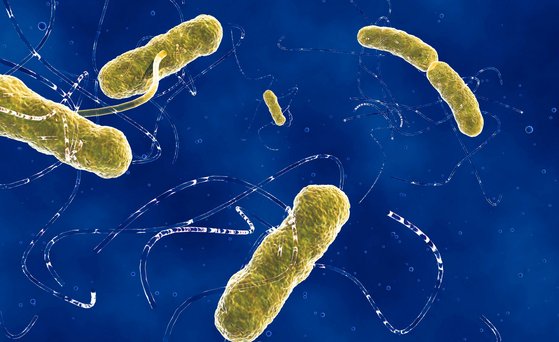Escherichia coli

Escherichia coli are a naturally occurring germ (commensal) in the intestine of birds and warm-blooded mammals. It is likewise an integral part of the intestinal flora of humans. Certain strains of Escherichia coli can cause serious diseases in animals and humans.
Symptoms and sources of infection of E. colishort forEscherichia coli bacteria
The significance of Escherichia coli as a cause of human infection has been known since the 1920s. E. coli is the most common cause of bacterial urinary tract infections and plays an important role. It is also a dreaded pathogen that causes blood poisoning and hospital-acquired infections. These germs are therefore also referred to as extraintestinal pathogenic E. coli (ExPEC), i.e. as pathogens that can cause disease outside the intestine.
Since the 1940s, however, E. coli has also increasingly been recognised as a cause of gastrointestinal diseases in humans. These germs are therefore also referred to as enteropathogenic E. coli (EPEC), i.e. germs that cause disease in the gastrointestinal tract. In the two decades following the Second World War, EPEC infections were the most important cause of gastroenteritis in infants and young children in industrialised countries. Improved hospital hygiene and better living conditions have contributed to the decline of EPEC infections in industrialised countries, but they still play an important role as pathogens in developing countries.
Other intestinal E. coli pathogens, such as enteroinvasive E. coli (EIEC) and enterotoxigenic E. coli (ETEC), are mainly of great importance in countries with warm climates and poor hygiene, whereas enteroaggregative E. coli (EAGEC) is also an important diarrhoea pathogen in industrialised countries.
EHECshort forenterohemorrhagic Escherichia coli and STECshort forShiga toxin-producing Escherichia coli
The E. coli strains STECshort forShiga toxin-producing Escherichia coli and EHECshort forenterohemorrhagic Escherichia coli can cause bloody diarrhoea and haemolytic uraemic syndrome. These variants of E. colishort forEscherichia coli were first recognised as zoonotic agents in 1982, after the Vero (VT) or shiga toxins (Stx) produced by the bacteria were identified. These toxins can have a significant organ-damaging effect.
These E. coli VTECshort forVero toxin-producing E. coli/STECshort forShiga toxin-producing Escherichia coli cause severe diarrhoea in humans. Some of them, also known as enterohemorrhagic E. coli (EHECshort forenterohemorrhagic Escherichia coli), are known to trigger bloody diarrhoea (haemorrhagic colitis) and kidney failure (haemolytic uraemic syndrome, HUS).
The E. colishort forEscherichia coli strains STECshort forShiga toxin-producing Escherichia coli and EHECshort forenterohemorrhagic Escherichia coli occur naturally in the intestines of ruminants such as cattle, sheep and goats. Animals that excrete STECshort forShiga toxin-producing Escherichia coli/EHECshort forenterohemorrhagic Escherichia coli germs show no signs of illness. The bacteria enter the environment through faeces.
In food production, foods of animal origin such as meat and dairy products are particularly at risk of being contaminated with STECshort forShiga toxin-producing Escherichia coli/EHECshort forenterohemorrhagic Escherichia coli bacteria. Direct transmission from animal to human and from human to human also plays an important role in the spread of STECshort forShiga toxin-producing Escherichia coli/EHECshort forenterohemorrhagic Escherichia coli infections.
In 2011, there was a major EHECshort forenterohemorrhagic Escherichia coli outbreak in Germany due to fenugreek seeds contaminated with EHECshort forenterohemorrhagic Escherichia coli bacteria that were used in the production of sprouts.